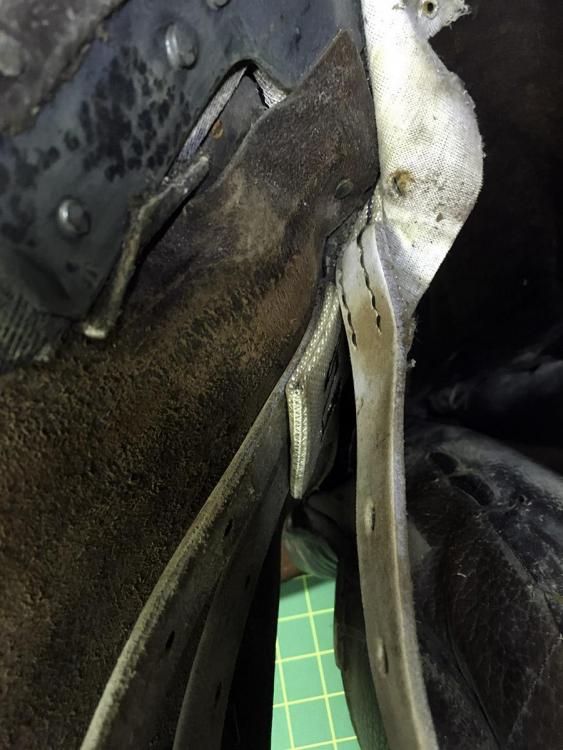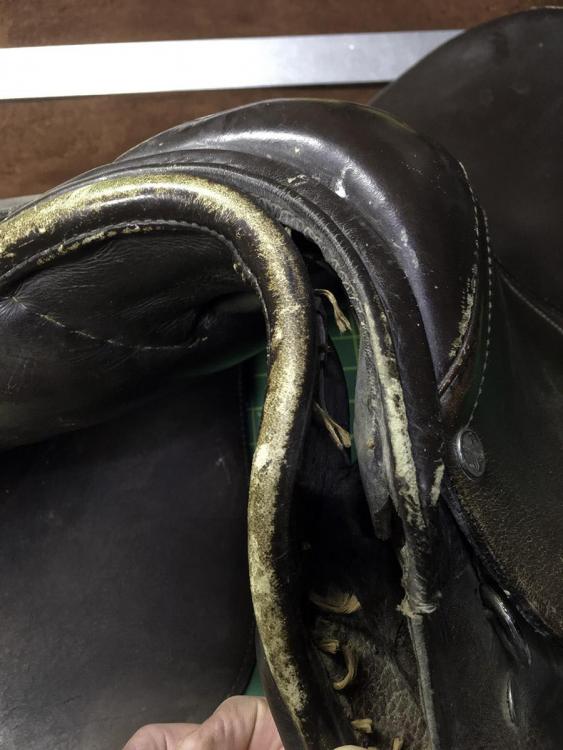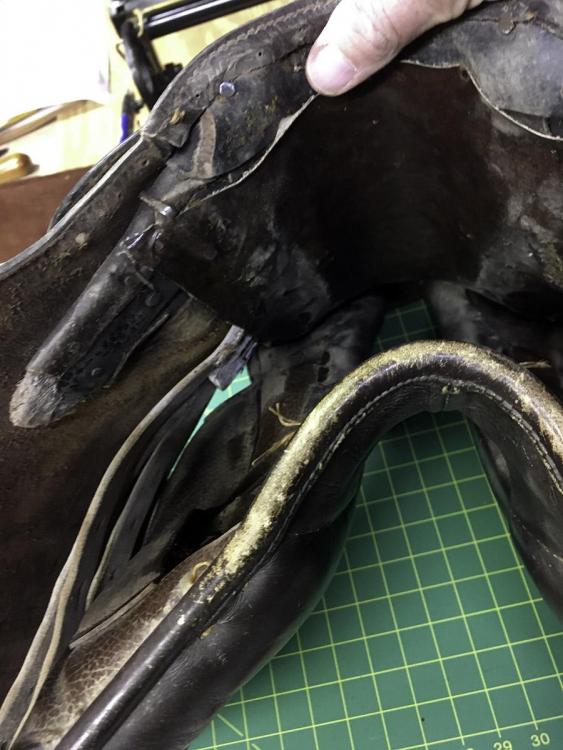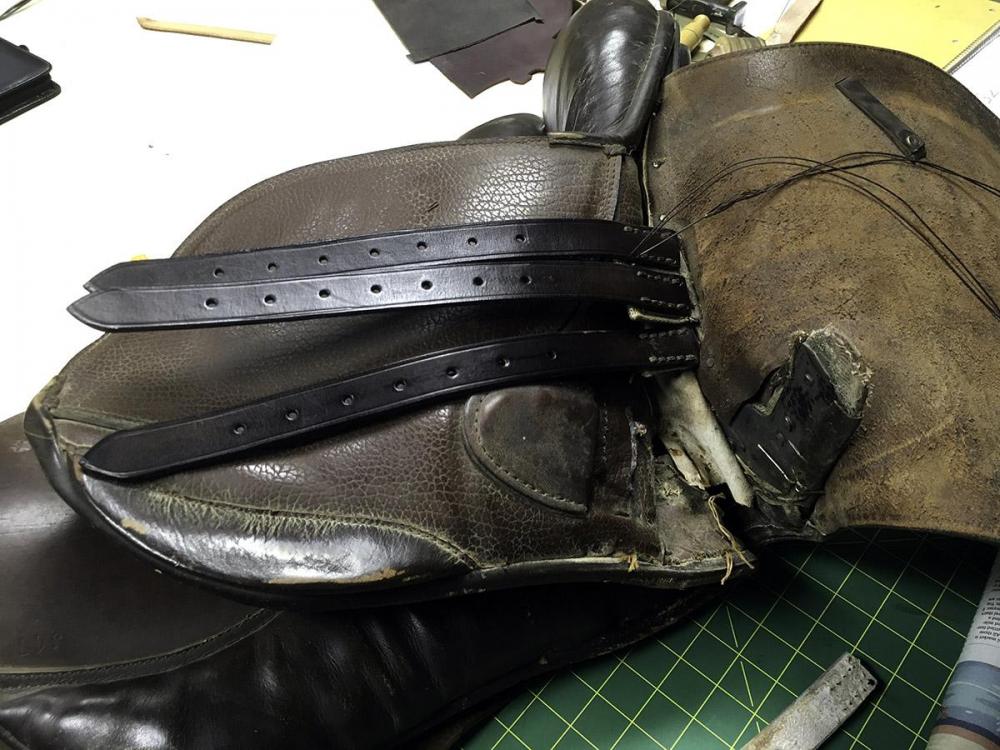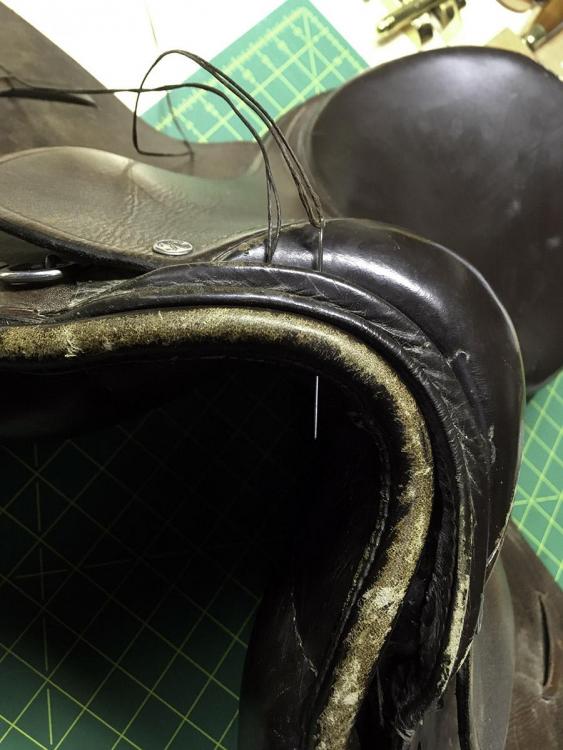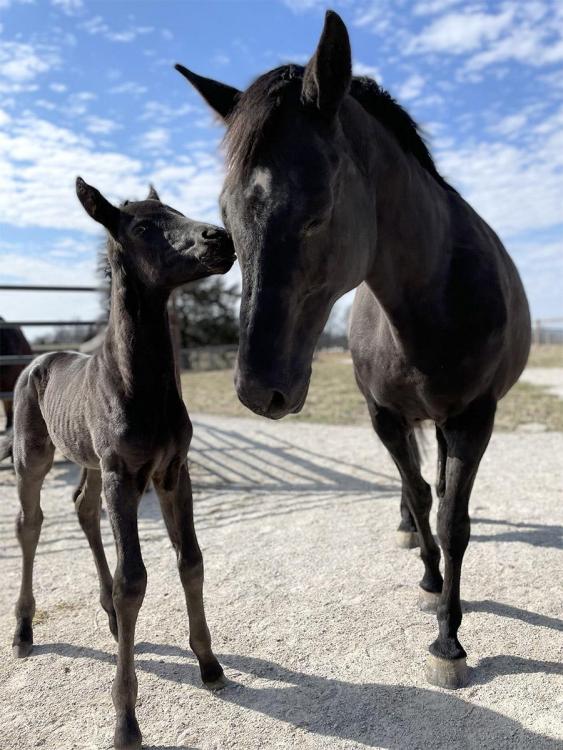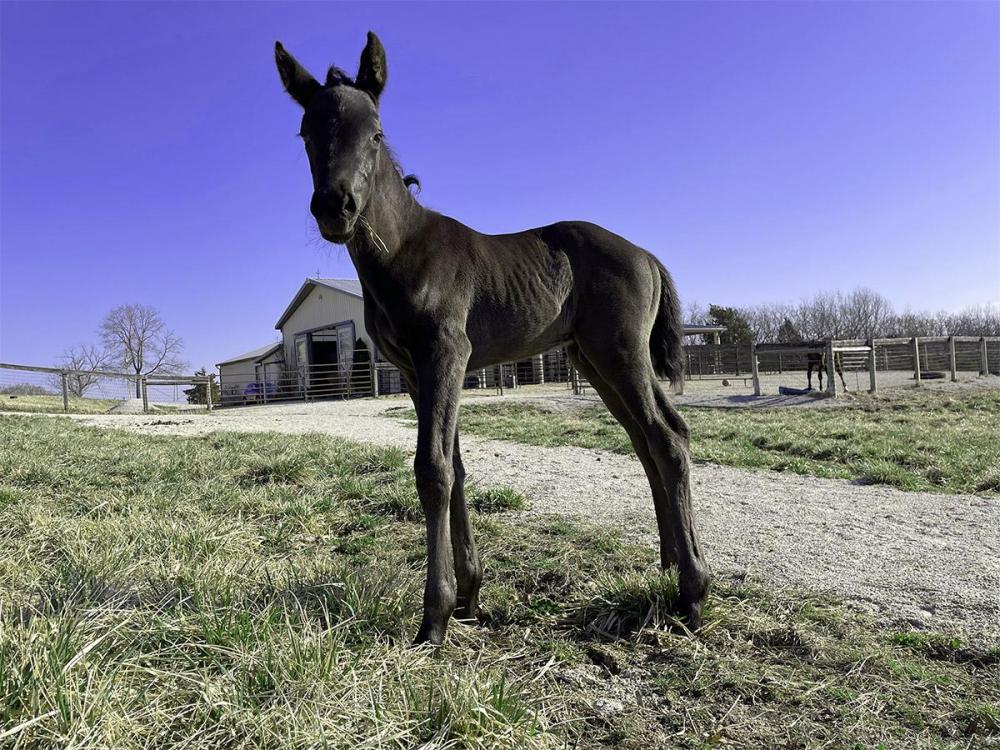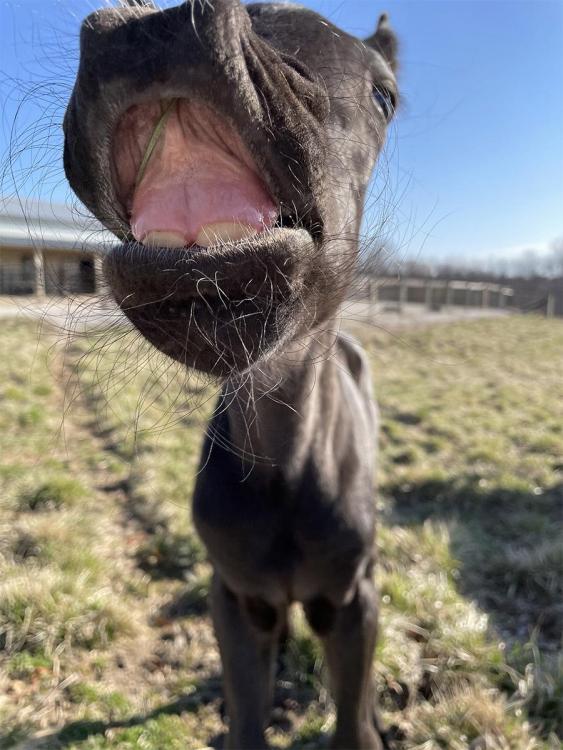-
Posts
1,282 -
Joined
-
Last visited
Content Type
Profiles
Forums
Events
Blogs
Gallery
Everything posted by TomE
-
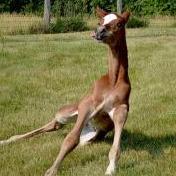
First Bag I'm Proud of!
TomE replied to MtlBiker's topic in Purses, Wallets, Belts and Miscellaneous Pocket Items
That's a beauty! I like the colors. Nice workmanship. -
Biothane is a great product and used for quality tack. Although I make leather tack in my spare time we use a lot of biothane halters in the barns. If a bird craps on them I just toss them in a bucket and hang to dry. They are very durable and practical for daily use. Nonetheless, my time is better spent making and repairing leather tack.
-

Cobra 26 presser/walking foot marking up leather
TomE replied to AtomicLeathers's topic in Leather Sewing Machines
Just firm tapping. I usually just tap on the backside with the front facing the granite slab. It helps to smooth the stitch line and even out thread tension. The marks probably won't be removed completely, but it should help. A shorter/weaker spring is likely to be the best solution. -
Mike Graham, owner of Ruxton's Trading Post in Manitou Springs CO, is an expert on old saddles. He used to write a column for Western Horseman answering questions about vintage saddles.
-

Cobra 26 presser/walking foot marking up leather
TomE replied to AtomicLeathers's topic in Leather Sewing Machines
Do you tap the stitches down after sewing? I use a small hammer with a polished face and place the leather on a granite slab. I am sewing bridle leather, not harness leather, with a Class 4. The presser foot marks the leather when the thickness is > 20 oz. even with the tension setting at a minimum. Tapping the stitches helps, and the marks fade somewhat with time. -
Nice collection of brasses! This book from master saddler Robert Steinke's Ebay store is informative. https://www.ebay.com/itm/223744242608 If you buy from the author he will sign the book.
-
That's a handsome bag! Really like the handle and choice of leather. Old school is timeless.
-
I backstitch 3 stitches when sewing halters, whether by hand or by machine. When halters break (as they should if a horse pulls hard enough) it's usually the leather that tears at a turn or a hole in the crown piece.
-

Can you buy die cut leather like for strap attachments
TomE replied to MtlBiker's topic in Leatherwork Conversation
Sounds good. Look forward to seeing it. Stohlman describes a number of ways to attach handles and straps in volume 2 of his case making books. -

Can you buy die cut leather like for strap attachments
TomE replied to MtlBiker's topic in Leatherwork Conversation
Another idea is to change the construction and run the tab ends through an oblong (crew punch) hole and sew/rivet in place with a decorative stitch on the outside of the bag. Would use a plain strap from same leather as the bag. This construction is stronger than a surface mounted tab for the Dee ring. -
Stohlman's book on leathercraft tools explains how to use and sharpen these tools. One aspect of the choice is using a disposable blade versus spending time and money on sharpening equipment.
-
Osborne makes left and right handed versions. The thimble is covered with a metal honeycomb that holds the eye of the needle securely. https://www.cutexsewingsupplies.com/products/c-s-osborne-sewing-palm-266-rh-for-right-hand-made-in-usa?variant=32878000013365 The palm works pretty well but it's faster to grab a pair of pliers, which work in either hand.
-
Coating thread with beeswax then smoothing the wax between your fingers will make your fingers slightly tacky and improve the grip. The wax coats the needles after a few stitches and also helps. I think the Osborne harness needles have a proportionately smaller eye.
-

Replacing girth straps on jumping saddle
TomE replied to TomE's topic in General Saddlery Discussion
Thanks once again, @jcuk. I greatly appreciate the education. Is the chrome tanned strap stronger than veg tanned? We have some nicer (that is, more expensive) saddles that appear to have veg tanned girth straps. -
I've seen white girth straps like this on several old saddles. They don't look like veg tanned leather - more like chrome tanned. Does anybody know what they're made of? Since the straps were stretched and looking worn, I replaced them. I dropped the front of the panel to gain access to the girth straps. The points of the tree were removed from pockets in the panel. I cut new straps from a HO bend, and sewed them on the webs using 1mm polyester thread, doubled up, with a single needle backstitch. The front of the panel was reattached with a pop stitch through the existing holes.
-

Headstall round sutured with silver ferrules
TomE replied to Turtlepaint's topic in How Do I Do That?
I haven't worked with ferrules but here's a link showing crimped ferrules on round cheek pieces for 5/8 inch hardware https://www.ranch2arena.com/products/041320-round-leather-with-ferrules-installed. For width of the round, Steinke ("Bridlework A Step-by-step Guide") starts with a 3/4 inch strap to make a round to fit 1/2 buckles. The strap is thinned where the round will be formed. He sews the cover around a piece of flexible, rubber coated multistrand wire. I use 1-1/4 inch straps to make rounded halter throat latches for 1 inch or 3/4 inch snaps. I split the cover to 7 oz thickness and wrap it around a 9 oz leather filler. The rounds end up being 1/2 - 5/8 inch diameter after shaping in a rein rounder. After rounding I trim the width of the ends to fit the hardware. I based my rounds on the descriptions of rounded leather handles in volume 2 of Al Stohlman's Case Making books. -
I assume you follow the usual practices to minimize dye ruboff. Fiebings Pro Dye and Fenice Colorfast dye produce less ruboff than other dyes I've tried. Prior to sewing, buff the work with a soft cloth until there's no more dye rubbing off. I quit using Tan Kote as a finish after sewing because it works like a dye solvent and discolors even bonded nylon thread. Then there's the failsafe - use dark colored thread.
-

Halter from the old German book on saddlery.
TomE replied to Mulesaw's topic in Saddle and Tack Accessory Items
Not sure how I missed this post, but wanted to say it's a beautiful piece of work! Really like the look of the leather, and the stitching is spot on. Do you have a clamp onboard to hold your work as you sew? Hope that Bent approves. -
This flexible, water-based adhesive is designed to finish the flesh side of leather. I use it for bridle parts made of a single layer of 9-10 oz bridle leather, including bridle leather with a pasted or moss-back. I apply it diluted 50:50 with water and work it into the fibers with a glass slicker. After the first coat dries, I apply a second coat and smooth it over with a paper towel. The adhesive penetrates several millimeters into the leather. If you build several coats it will repel water and neatsfoot oil. I am evaluating how well it holds up with tack but so far I am pleased with the results.
-
@Mulesaw I recently discovered the book "Saddlery and Harness-Making" by Paul Hasluck. It is a reprint of 2 volumes originally published in 1904 and available in hardback and paperback editions from used book sellers. The book has considerable detail about tools, materials, and instructions for making saddles, various pieces of bridlework, and harness. There are many illustrations. The book doesn't fill all the gaps in my understanding of the subject, but I am learning a great deal about the why and how of saddlery. It's a fun read.
-
He is a warmblood bred for dressage. He's a bit of a spitfire at this stage of his life. The Caspian horses are less than 13 hands and bred as children's hunter ponies. The remainder of this year's foals will be warmbloods bred for jumping.
-
-

Half round knife sheath
TomE replied to Rossr's topic in Gun Holsters, Rifle Slings and Knife Sheathes
That's a beauty! Wish it was coming my way. I really like the colors and detail on the sheath. -
@Mulesaw if you're on Facebook see our Maefield Farm page or my personal page (Tom Ellenberger). I can post here if you don't do FB.
-
Nice! It is foaling season for us. One colt born 3 weeks ago and 3 more foals expected in May.



